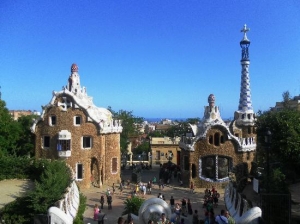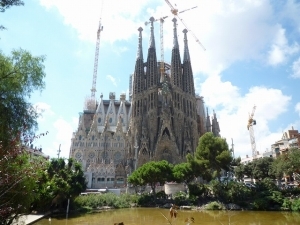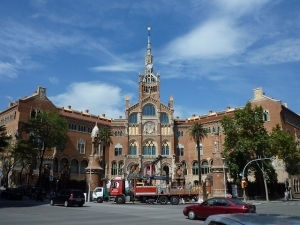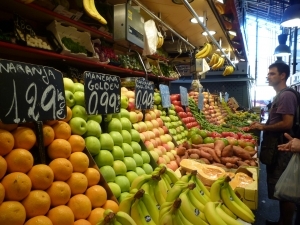Cool-Barcelona is a website in which covers information on Hotels, tour,food,shopping,sightseeing,and more. You are experiencing Barcelona without even visiting!
 Welcome,Guest User
Welcome,Guest User
Home > Barcelona
Cool-Barcelona is a website in which covers information on Hotels, tour,food,shopping,sightseeing,and more. You are experiencing Barcelona without even visiting!
Home > Barcelona

Barcelona is a huge city with several district articles containing sightseeing, restaurant, nightlife and accommodation listings.
Barcelona is the capital and largest city of Catalonia and Spain's second largest city, with a population of over one and half million people.
This city, located directly on the northeastern Mediterranean coast of Spain, has a rich history, having been under Roman, then Frank law before declaring its independence.
This beautiful city is full of what European cities are known for (outdoor markets, restaurants, shops, museums and churches) and is fantastic for walking with an extensive and reliable Metro system for more far-flung destinations. The core centre of town, focused around the Ciutat Vella provides days of enjoyment for those looking to experience the life of Barcelona while the beaches the city was built upon provide sun and relaxation during the long periods of agreeably warm weather.
The Eixample is the quarter designed during the middle of the 19th century by Ildefons Cerdà, expanding the medieval city of Barcelona into space left empty for defense outside the city walls. It's an enormous field of rectangular blocks in an continuously repeating layout, with the constant threat of getting lost (at least for those used to European cities). Eixample contains most of the modernist buildings, including La Pedrera, Casa Batlló and La Sagrada Família. A very interesting example for planned urban development and subsequent re-planing and restructuring.

【Sagrada Família】
The Basílica i Temple Expiatori de la Sagrada Família is a large Roman Catholic church, designed by Catalan architect Antoni Gaudí (1852–1926). Although incomplete, the church is a UNESCO World Heritage Site, and in November 2010 Pope Benedict XVI consecrated and proclaimed it a minor basilica,\ as distinct from a cathedral which must be the seat of a bishop.

【Casa Mila】
Casa Milà is a modernist building located at 92, Passeig de Gràcia (passeig is Catalan for promenade) in Barcelona, at the corner of Carrer de Provença, in the Eixample. It was the last civil work designed by Catalan architect Antoni Gaudí and it was built between the years 1906 and 1910.

【Casa Batllo】
Casa Batlló is a renowned building located in the center of Barcelona and is one of Antoni Gaudí’s masterpieces. A remodel of a previously built house, it was redesigned in 1904 by Gaudí and has been refurbished several times after that. Gaudí's assistants Domènec Sugrañes i Gras, Josep Canaleta and Joan Rubió also contributed to the renovation project. The local name for the building is Casa dels ossos (House of Bones), as it has a visceral, skeletal organic quality. It was originally designed for a middle-class family and situated in a prosperous district of Barcelona.

【Hospital de Sant Pau】
The former Hospital de la Santa Creu i Sant Pau is a complex built between 1901 and 1930, designed by the Catalan modernist architect Lluís Domènech i Montaner. Together with Palau de la Música Catalana, it is a UNESCO World Heritage Site. It was a fully functioning hospital until June 2009, it is currently undergoing restoration for use as a museum and cultural center. As of December 2013 there are still tours of the hospital being given several times a day.
La Rambla is a street in central Barcelona, popular with tourists and locals alike. A tree-lined pedestrian mall, it stretches for 1.2 kilometres (0.75 mi) connecting Plaça de Catalunya in the centre with the Christopher Columbus Monument at Port Vell. La Rambla forms the boundary between the quarters of Barri Gòtic, to the east, and El Raval, to the west.
La Rambla can be crowded, especially during the height of the tourist season. Its popularity with tourists has affected the character of the street, with a move to pavement cafes and souvenir kiosks. It has also suffered from the attention of pickpockets and, especially towards its southern end, sex workers.

【Plaça Reial】
Plaça Reial is a square in the Barri Gòtic of Barcelona, Catalonia, Spain. It lies next to La Rambla and constitutes a well-known touristic attraction, especially at night. On the plaza are a large number of restaurants and some of the city's most famous nightclubs including Sidecar, Jamboree or Karma. It is also known for its many outdoor venues and is a popular meeting place during the summer and the annual La Mercè festival in September, when open air concerts take place, and during other celebrations such as New Year's Eve, often being very crowded.

【Plaça de Catalunya】
Plaça de Catalunya is a large square in central Barcelona that is generally considered to be both its city centre and the place where the old city (see Barri Gòtic and Raval, in Ciutat Vella) and the 19th century-built Eixample meet.

【La Boqueria】
La Boqueria is a large public market in the Ciutat Vella district of Barcelona, Catalonia, Spain and one of the city's foremost tourist landmarks, with an entrance from La Rambla, not far from the Liceu, Barcelona's opera house. The market has a very diverse selection of goods.